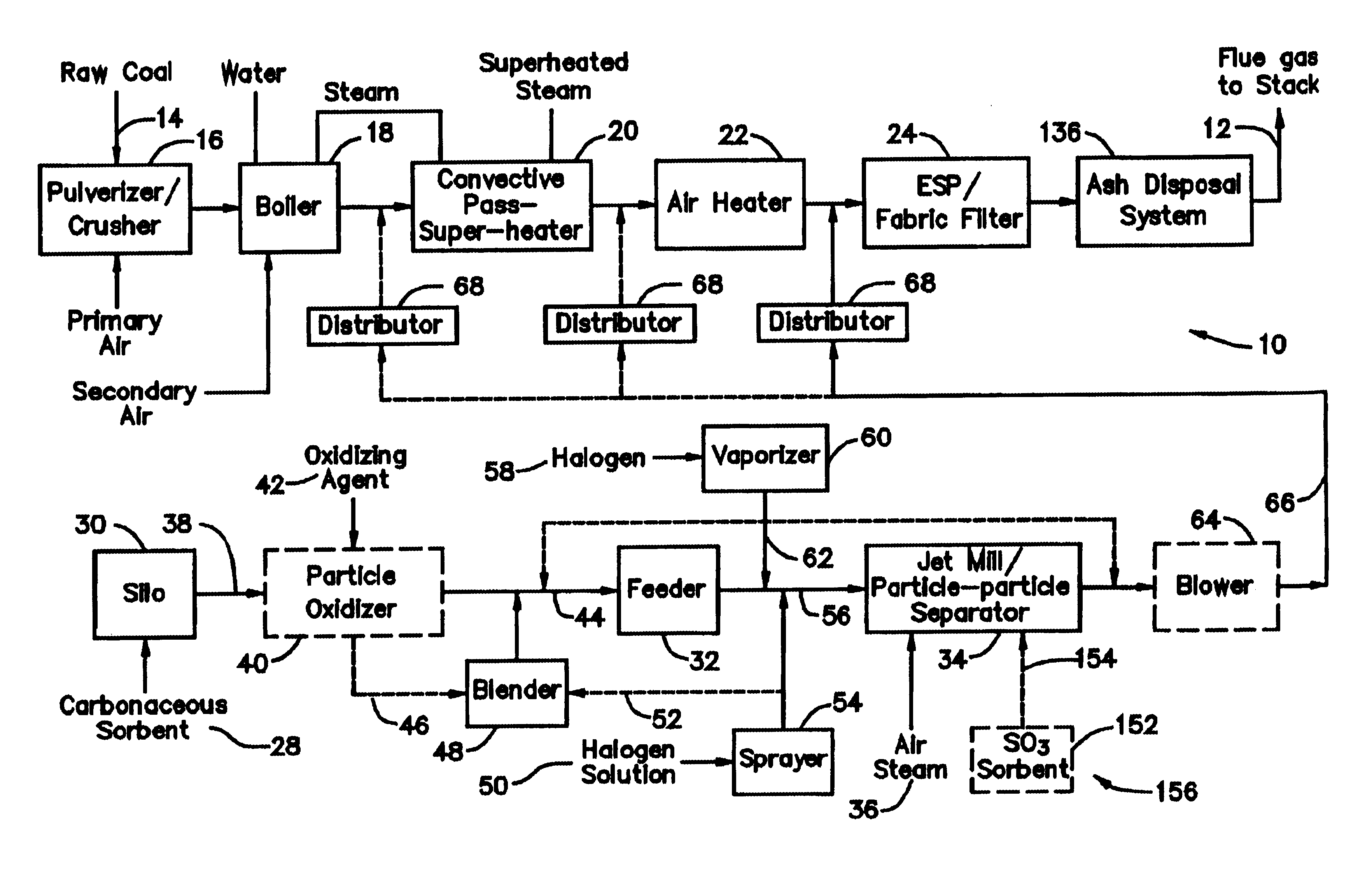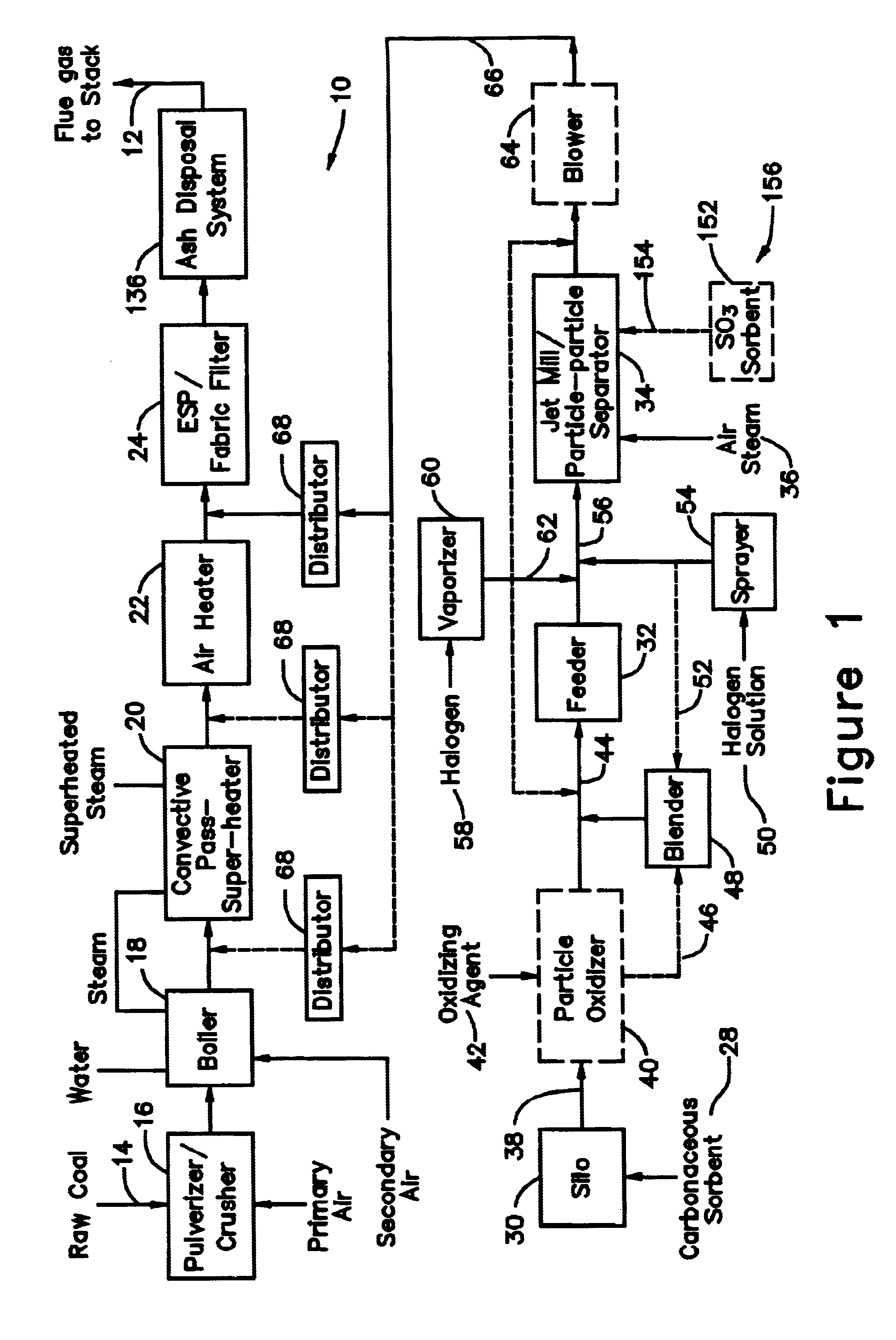Control of mercury emissions from solid fuel combustion
a solid fuel combustion and mercury technology, applied in the direction of emission prevention, separation processes, lighting and heating apparatus, etc., can solve the problems of difficult removal of mercury from flue gas from coal-fired power plants, limited utilization factor of activated carbon, and high difficulty in storage, handling, transportation and dispersion of these articles, so as to enhance the capture of elemental mercury and eliminate pollutants
- Summary
- Abstract
- Description
- Claims
- Application Information
AI Technical Summary
Benefits of technology
Problems solved by technology
Method used
Image
Examples
fourth embodiment
[0027]FIG. 8 is a schematic diagram of a system in accordance with the present invention for removing elemental mercury or mercury compounds from the flue gases from coal combustion;
[0028]FIG. 9 is a graph illustrating conversion (%) of soot, CO, and HC as a function of temperature (° C.); and
[0029]FIG. 10 is a graph illustrating a typical destruction profile for CO and HC with a PGM catalyst.
DETAILED DESCRIPTION OF THE PREFERRED EMBODIMENT
[0030]With reference to FIG. 1, there is illustrated therein an exemplary fuel conversion arrangement for converting a fuel—namely, a solid fossil fuel in the form of coal—into a desired energy form. The exemplary fuel conversion arrangement illustrated in FIG. 1 effects the fuel conversion via combustion of coal and is illustratively configured as a typical 100 MWe coal firing plant 10 which combusts approximately 40 tons / hr of coal with a flue gas flow 12 of about 350,000 Nm3 / hr. The raw coal is fed 14 to a pulverizer / crusher 16 where the raw co...
first embodiment
[0031]In a system 26 for removing elemental mercury or mercury compounds, a starter batch of carbonaceous sorbent is in the form of carbonaceous sorbent 28 stored in a silo 30, with the carbonaceous sorbent 28 being in an agglomerated state because the very small particles thereof tend to stick to each other. Accordingly, the starter batch of the sorbent 28 is fed by a feeder 32 to a separation device 34, which comminutes (if necessary) and de-agglomerates the sorbent particles 28 into a contact batch of carbonaceous sorbent and a retained batch of carbonaceous sorbent. The contact batch of carbonaceous sorbent has a particle size distribution of carbonaceous sorbent of d5050 represents 50% of the particles by mass in the entire distribution in the contact batch with the particle size distribution of carbonaceous sorbent in the contact batch after separation being less than the particle size distribution of carbonaceous sorbent in the starter batch before separation and less than th...
second embodiment
[0040]In a system for removing elemental mercury or mercury compounds in accordance with the present invention and shown in FIG. 2, hereinafter designated as a system 69 for removing elemental mercury or mercury compounds, a portion of the coal pulverized in the pulverizer 16 is extracted at a location 70 from the pulverizer exit as sorbent 28. Preferably between 10 to 1000 lb / hr of coal (about 0.01 to 1.0 percent of total coal feed to boiler), more preferably between 50 and 500 lb / hr, and most preferably between 100 and 200 lb / hr is extracted at the location 70. A blower 72 may be required to provide the necessary motive force for moving the extracted sorbent solids 28.
[0041]The extracted sorbent solids 28 are subjected to one or more processes. The sorbent solids 28 may be sprayed at a location 74 with a solution 50 to deposit a halogen on the surface of the sorbent particles 28. The solution 50 is chosen from potassium iodide, iodine dissolved in potassium iodide, alkali halides ...
PUM
| Property | Measurement | Unit |
|---|---|---|
| Fraction | aaaaa | aaaaa |
| Size distribution | aaaaa | aaaaa |
| Pressure | aaaaa | aaaaa |
Abstract
Description
Claims
Application Information
 Login to View More
Login to View More - R&D
- Intellectual Property
- Life Sciences
- Materials
- Tech Scout
- Unparalleled Data Quality
- Higher Quality Content
- 60% Fewer Hallucinations
Browse by: Latest US Patents, China's latest patents, Technical Efficacy Thesaurus, Application Domain, Technology Topic, Popular Technical Reports.
© 2025 PatSnap. All rights reserved.Legal|Privacy policy|Modern Slavery Act Transparency Statement|Sitemap|About US| Contact US: help@patsnap.com



